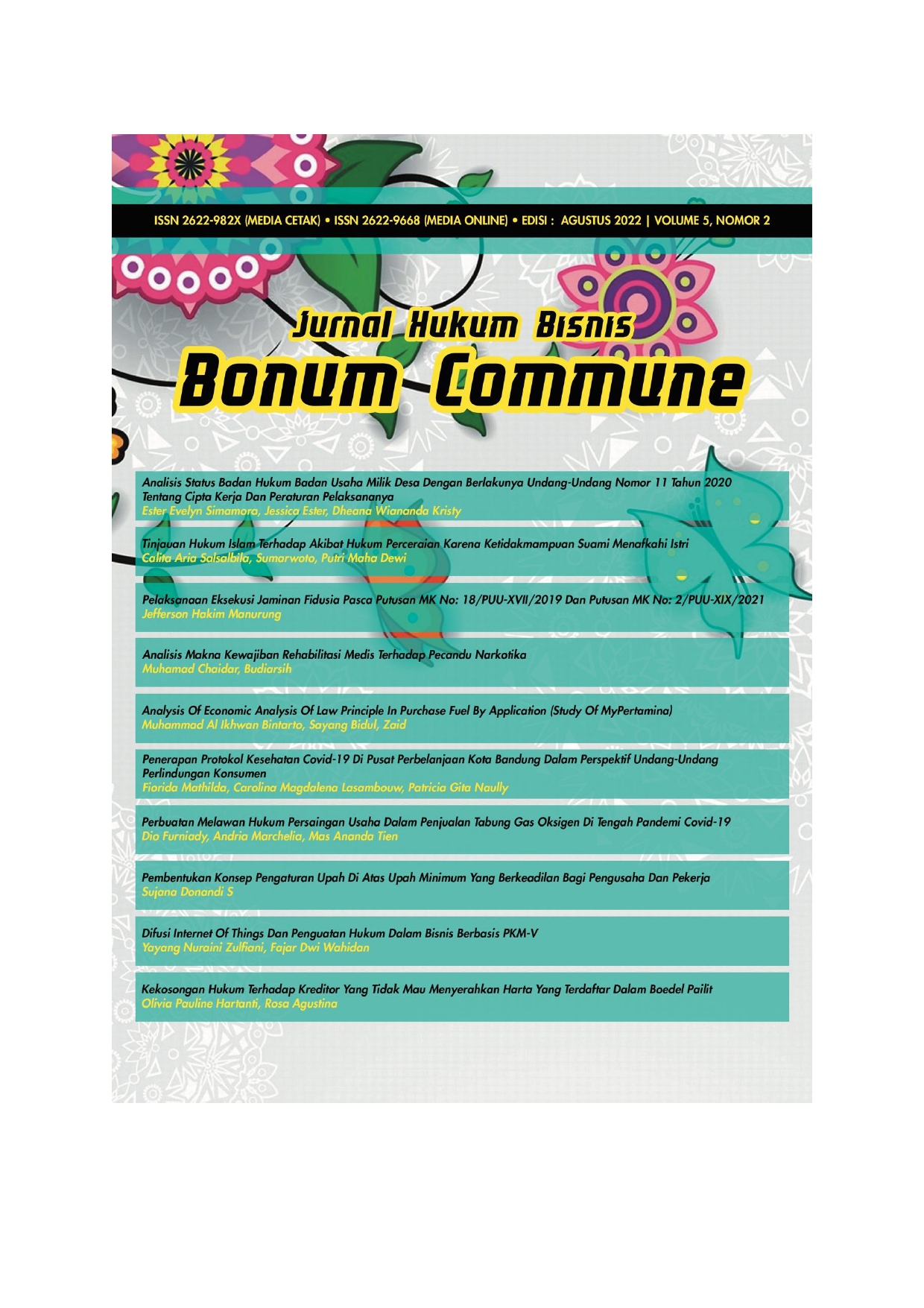Legal Certainty of Home Industry Food Through National Agency of Drug And Food Control’s Post Market In View From Law No. 8 of 1999 Concerning Consumer Protection
Abstract
Abstrak
Beredarnya produk olahan dari industri rumah tangga saat ini menjadikan sertifikasi standardisasi produk penting sebagai upaya perlindungan masyarakat. Kajian ini bertujuan untuk menjelaskan kepastian hukum Pangan Industri Rumah Tangga dan pos pasar Balai Pengawas Obat dan Makanan sebagai upaya perlindungan konsumen. Metode yang digunakan dalam penelitian ini adalah metode yuridis normatif yang dilakukan dengan pendekatan perundang-undangan dan dengan pendekatan analitis. Spesifikasi yang digunakan adalah deskriptif konseptual. Data yang akan digunakan adalah data sekunder termasuk perundang-undangan dan literatur yang relevan dengan Pangan Industri Rumah Tangga dan Post Market Balai Pengawas Obat dan Makanan. Dari penelitian yang dilakukan diperoleh hasil bahwa penerapan Pangan Industri Rumah Tangga berdasarkan Peraturan Balai Pengawas Obat dan Makanan No. 22 Tahun 2018 dapat menjadi perlindungan bagi masyarakat dari produk berbahaya. Sebagai tanggung jawab pengawasan terhadap produk yang telah diberikan sertifikat Pangan Industri Rumah Tangga, pelaksanaan pengawasan pos pasar oleh Balai Pengawas Obat dan Makanan atas dasar pelaksanaan Peraturan Balai Pengawas Obat dan Makanan No. 9 Tahun 2020 sebagai bentuk perlindungan hak konsumen sebagaimana diatur dalam UU No. 8 Tahun 1999 tentang Perlindungan Konsumen. Dalam penerapannya, keduanya menunjukkan kepastian hukum yang jelas bagi konsumen.
Kata kunci: pangan industri rumah tangga; perlindungan hukum; pos pasar
Abstract
The current circulation of processed products from home industries makes product standardization certification important as an effort to protect the public. This study aims to explain the legal certainty of Home Industry Food and the National Agency of Drug and Food Control post market as an effort to protect consumers. The method used in this research is the normative juridical method which is carried out with a statutory approach and with an analytical approach. The specification used is conceptual descriptive. The data that will be used is secondary data including legislation and literature relevant to Home Industry Food and Post Market National Agency of Drug and Food Control. From the research conducted, the results showed that the implementation of Home Industry Food based on National Agency of Drug and Food Control regulation No. 22 of 2018 can be a protection for the public from harmful products. As a responsibility for the supervision of products that have given Home Industry Food certificates, the implementation of post market supervision by National Agency of Drug and Food Control on the basis of implementation of National Agency of Drug and Food Control Regulation No. 9 of 2020 as a form of protecting consumer rights as stipulated in Law no. 8 of 1999 concerning Consumer Protection. In their application, both show clear legal certainty for consumers.
Keywords: home industry food; legal protection; post market
Downloads
References
Sucihatiningsih. Strategy to Realize Food Security. Semarang State University Expert Paper. 2022. (https://unnes.ac.id/pakar/strategi-meJadikan-ketahanan-pangan) accessed on 11 September 2022.
PP No. 28 of 2004. Food safety, quality and nutrition . Regulation of the Government of the Republic of Indonesia. Jakarta, 2004.
Basuki, U. (2020). Tracing the constitutionalism of the right to health services as a human right. Journal of Law Caraka Justitia, 1(1), 21-41.
Ardinata, M. (2020). State Responsibility for Health Insurance in the Perspective of Human Rights. Human Rights Journal, 11(2), 319-332.
Kurniati, SD, Suparnyo, S., & Alladuniah, MA (2021). CONSUMER PROTECTION OF THE DISTRIBUTION OF SNACK FOOD WHICH HAS NOT HAVE A HOME INDUSTRY LICENSE (P-IRT) IN KUDUS REGENCY. Journal of Justice Voice, 22(2), 171-185.
Riduan Syahrani, Summary of the Essence of Law Science, Publisher Citra Aditya Bakti, Bandung, 1999, p.23.
MSME School. WHAT IS PIRT: Definition, Legal Basis, and How to Get It. 2022. ( https://www.schoolumkm.id/blog/detail/23/apa-itu-pirt/ ) accessed 11 September 2022.
Indonesian POM Agency. Profile of the Indonesian Food and Drug Monitoring Agency. ( https://www.pom.go.id/new/view/direct/strategic ) accessed 11 September 2022.
Ahmad Naufal Dzulfarah. BPOM Finds Dangerous Coffee Still in the Online Market, Here's the Marketplace Response. Kompas.com 07/03/2022. accessed September 11, 2022.
Arrahman, YR, & Mustarichie, R. (2018). AUTHORITY AND FLOW OF EXAMINATION BY BANDUNG CENTER FOR DRUG AND FOOD CONTROL ON CASES OF FINDING OF WORMS PARASITES IN MACHINERY PRODUCTS. Pharmaca, 16(1), 21-26.
Poernomo, SL (2020). Analysis of Consumer Legal Protection for Packaged Food Products Circulating in Makassar City. Gorontalo Law Review, 3(1), 40-58.
Sudewi, NKAPA, Budiartha, INP, & Ujianti, NMP (2020). Legal Protection for the Food and Drug Supervisory Agency (BPOM) Against the Circulation of Herbal Products Containing Dangerous Medicinal Chemicals. Journal of Legal Analogy , 2 (2), 246-251.
Hakim, AR (2020). Consumer protection against the circulation of food and beverage products without a label. Yustitiabelen , 6 (2), 98-110.
Hermanu, B. (2016). Study on the implementation of distribution permits for home industry food products (PIRT) in realizing optimal food safety in the city of Semarang. Scientific Journal of Law and Community Dynamics , 11 (2).
Saleh, M., Dilaga, ZA, & Fitrahadi, KF (2019). Government Policy Regarding Standardization of Food and Beverage Products in Encouraging Fair Business Competition. Journal of Compilation of Laws , 4 (2), 155-172.
Authors who publish with Jurnal Hukum Bisnis Bonum Commune agree to the following terms:
- Authors transfer the copyright and grant the journal right of first publication with the work simultaneously licensed under a Creative Commons Attribution-ShareAlike 4.0 International License.. that allows others to share the work with an acknowledgement of the work's authorship and initial publication in this journal.
- Authors are able to enter into separate, additional contractual arrangements for the non-exclusive distribution of the journal's published version of the work (e.g., post it to an institutional repository or publish it in a book), with an acknowledgement of its initial publication in this journal.
- Authors are permitted and encouraged to post their work online (e.g., in institutional repositories or on their website) prior to and during the submission process, as it can lead to productive exchanges, as well as earlier and greater citation of published work (See The Effect of Open Access)






